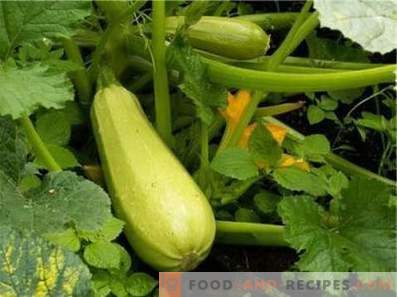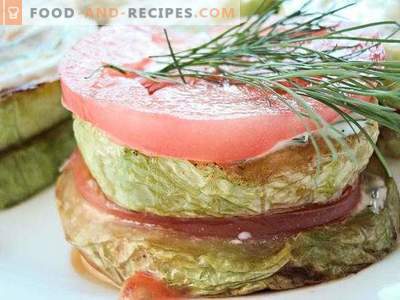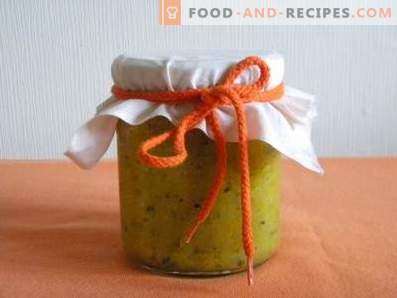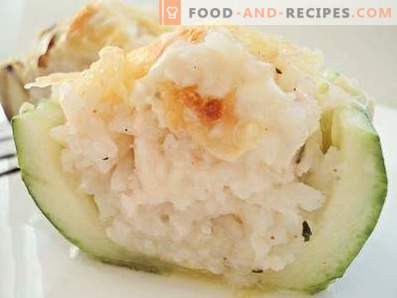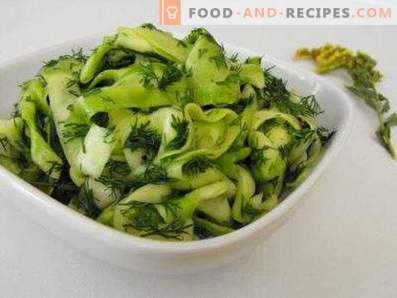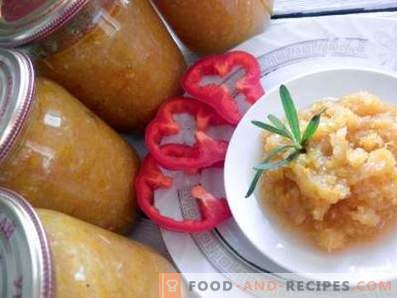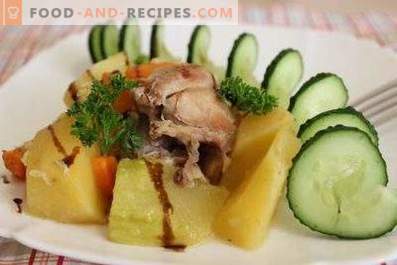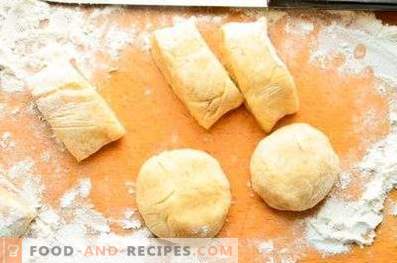
Zucchini, pumpkin, squash, zucchini ...
Despite the apparent difference between these vegetables, they all belong to the same family - pumpkins.
But if it is simply impossible to confuse a pumpkin with a squash, then zucchini and zucchini resemble each other like brothers, especially at a young age. And no wonder. After all, zucchini is the same zucchini. It was just that the breeders did a good job of its appearance, and in the end it turned out to be a quick-ripening, fruitful and valuable vegetable with its taste qualities. And not only taste.
After all, zucchini, however, like ordinary zucchini, not only tasty, but also have a lot of other advantages.
Useful properties of zucchini
- There are sugars, proteins, starch, pectins, phosphorus, iron, potassium, sodium, pantothenic and folic acids in the flesh of zucchini.
- In zucchini there are vitamins C, B1, B2, PP.
- Zucchini has fiber, although a little, so they improve the performance of the gastrointestinal tract.
- Zucchini and zucchini are good for diet food, as they are low-calorie.
- Squashes possess diuretic, antinemic, antiallergic properties.
- They remove the excess cholesterol from the body and are a choleretic agent.
But still there are differences between them.
How zucchini differ from ordinary zucchini
In contrast to the usual zucchini zucchini, the fruit is early ripening. Its fruiting begins in June. Fruits are harvested twice a week (or even more often), when the greens are no more than 10-15 cm in length. At this time, zucchini has a very delicate green skin, and their mass does not exceed 400 grams. Zucchini differs from zucchini in color. Zucchini most often are dark green in color, all shades of green, sometimes striped. Zucchini in addition to green color may have a white or light yellow color of the peel.
The difference between zucchini and zucchini and in the growth of the fruit. If zucchini grows in length only up to 20-25 cm, then an adult zucchini can reach quite impressive sizes. Especially if grown “outstanding” instances, for example, for the exhibition. The fact is that zucchini can regulate fruit formation itself. On the plants of the pumpkin family, it means, and in squash, never grow more fruits than they can feed. You can grow a large zucchini, if you cut off all the ovaries, leaving one fruit.
Zucchini can be eaten raw, which is not the case with ordinary zucchini. For eating raw zucchini removed from the bush when they grow no more than 15 cm in length and have a weight of 130-150 grams. At this time, zucchini has a firm, crunchy, tender flesh. The fruits are cut with a knife. This method stimulates the formation of new ovaries - fruits.
Squash seasoned until September. So that they are not damaged by slugs, and do not touch the rot, they are isolated from the ground by placing plywood boards, pieces of glass or a layer of mulch under the fruit. Summer varieties of zucchini are harvested as they mature.
Zelentsi have a higher nutritional value and good taste - young squash of zucchini until twelve days old weighing no more than 700 grams, up to 25 cm long and 10 cm in diameter. with seeds already appeared. For cooking, squash is cut at the stalk, the skin is removed and part of the pulp is removed with the seeds that appear. Zucchini is not consumed raw, but is stewed, fried, boiled and baked.
Late-ripening varieties of zucchini cleaned before the most frost in September.
When zucchini has already formed a thick crust, they are well tolerated storage. Store them in nets or on shelves in a well-ventilated area. Zucchini cannot be stored due to their soft skin. Therefore, they are used soon after collection.
Zucchini do not tolerate cold spells and even more frost. To get an early harvest, they are planted in the form of seedlings in greenhouses, under shelters, where the soil warms up well. Shelters are removed only when the threat of frost will pass.

